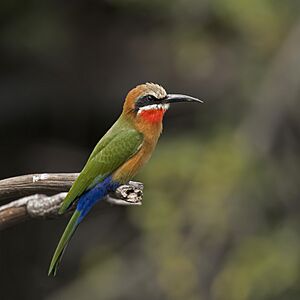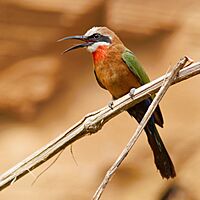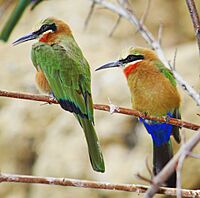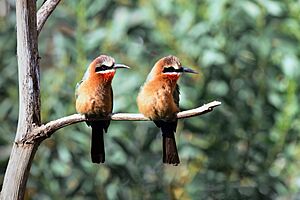White-fronted bee-eater facts for kids
Quick facts for kids White-fronted bee-eater |
|
|---|---|
 |
|
| In Namibia | |
| Conservation status | |
| Scientific classification | |
| Genus: |
Merops
|
| Species: |
bullockoides
|
The white-fronted bee-eater (Merops bullockoides) is a colorful bird found across parts of Africa. It belongs to the bee-eater family. This bird is easy to spot with its unique white forehead. It also has a square tail and a bright red patch on its throat.
White-fronted bee-eaters live in groups. They dig nests in cliffs or riverbanks. You can often see them perched on low trees. They wait there to catch flying insects. They are very skilled hunters.
Contents
What Does a White-fronted Bee-eater Look Like?
Like other bee-eaters, this bird is very colorful. It has a slender body. A special feature is its black mask around the eyes. It also has a white forehead. Its tail is square-shaped. A bright red patch marks its throat.
These birds are about 23 centimeters (9 inches) long. Their upper parts are green. Their underparts are a warm cinnamon color. When they call, it sounds like a deep squeak.
Where Do White-fronted Bee-eaters Live?
White-fronted bee-eaters live in the huge savannah areas of sub-equatorial Africa. They prefer open areas. These places are often near gullies. Gullies are good spots because bees, their main food, often live there.
How Do White-fronted Bee-eaters Behave?
Nesting and Reproduction
White-fronted bee-eaters nest in large groups. These groups are called colonies. A colony can have around 200 birds. They dig holes in cliffs or earth banks. These holes are used for sleeping and nesting.
A group of bee-eaters might fly over many kilometers of savannah. But they will always return to the same colony. They come back to sleep, socialize, and raise their young. White-fronted bee-eaters have very complex family lives. Their social system is one of the most interesting among birds.
Their colonies are made of "clans." These are extended family groups. Different generations live together. They also practice something called "cooperative breeding." This means that birds who are not breeding themselves help other family members. They help raise the young of their relatives.
This helping behavior is very common in white-fronted bee-eaters. Helpers assist in about half of all nesting attempts. These helpers do many things. They help dig the nest chambers. They feed the female bird. They also help incubate the eggs. And they feed the young chicks. Helpers greatly increase the number of young birds that survive.
Not all non-breeding birds become helpers. About half of them do. Whether a bird helps depends a lot on how closely related they are. Birds are most likely to help when the breeding pair is a close relative. If they have a choice, helpers will pick the nest of their closest family. This suggests that helping helps the helper's own genes get passed on.
Feeding and Diet
Their main food is bees. But they also eat other flying insects. What they eat can change with the season. It also depends on what insects are available.
Scientists have seen two main ways they hunt. One way is to make quick flights from low branches. They swoop out to catch insects in the air. The other way is to glide slowly down from their perch. Then they briefly hover to grab their prey.






